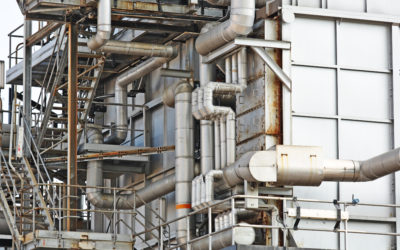The Role of HeatX in Preventing Metal Failure
Premature metal failure is a common issue in heat exchangers, which are critical components in many industrial processes. From oil and gas to manufacturing and energy production, heat exchangers endure extreme temperature fluctuations and corrosive environments. Over time, this exposure can lead to cracks, fractures, or complete equipment failure. Understanding the causes of premature metal failure and finding effective solutions, such as Oceanit’s HeatX coating, is essential for maintaining efficiency and reducing operational costs.
Common Causes of Premature Metal Failure in Heat Exchangers
Premature metal failure in heat exchangers occurs due to several key factors:
- Corrosion: Corrosion is the most common cause of metal failure, occurring when chemicals in process fluids degrade metal surfaces. High temperatures, aggressive chemicals, and improper material selection accelerate corrosion.
- Erosion: Erosion results from high-velocity fluids or abrasive particles flowing through the heat exchanger. It gradually wears down the metal and reduces its strength.
- Thermal Stress: Heat exchangers experience rapid temperature changes, causing metal components to expand and contract. Over time, this leads to stress concentration, which can cause fractures or cracks in the metal.
- Fatigue: Repeated stress, such as vibration or pressure fluctuations, causes microcracks that grow over time, eventually leading to failure. Fatigue is a gradual process that results from long-term use in challenging conditions.
- Creep: Creep occurs when metal deforms under constant stress at high temperatures, leading to structural changes that compromise the equipment’s integrity.
- Material Incompatibility: Incompatible materials used in construction can lead to galvanic corrosion or other chemical reactions, weakening the metal and reducing the equipment’s lifespan.
These causes contribute to a range of consequences, including costly repairs, equipment downtime, and reduced productivity. Without proper preventative measures, heat exchangers can suffer from significant operational inefficiencies, leading to increased energy consumption and a higher risk of safety incidents.
The Cost of Premature Metal Failure
The financial implications of premature metal failure can be severe:
- Replacement or Repair Costs: Replacing or repairing damaged components is expensive, especially if the entire heat exchangers need replacement.
- Downtime and Production Loss: Unplanned maintenance due to metal failure results in production delays, lost productivity, and missed production targets, which negatively impacts the company’s bottom line.
- Increased Energy Consumption: A failing heat exchanger operates inefficiently, consuming more energy to achieve desired performance levels, which increases utility costs.
- Safety and Environmental Risks: Severe metal failures may pose safety hazards or lead to environmental concerns, potentially resulting in fines or regulatory violations.
How HeatX Coating Provides the Solution
Oceanit’s HeatX coating is a revolutionary nanocomposite surface treatment designed to tackle the issues that lead to premature metal failure in heat exchangers. HeatX is a protective, omniphobic coating that offers several key advantages to prevent corrosion, erosion, and thermal stress:
- Corrosion Resistance: HeatX provides excellent protection against corrosive environments, extending the life of the metal surfaces in heat exchangers. Its omniphobic properties repel both water and oil-based substances, preventing the accumulation of corrosive elements on the metal.
- Erosion Protection: By creating a slick, low-friction surface, HeatX minimizes the abrasive effects of fluid flow, reducing the risk of erosion-related metal degradation.
- Enhanced Thermal Stability: HeatX’s advanced formulation is designed to withstand the rapid temperature changes experienced by heat exchangers, preventing the formation of cracks or fractures due to thermal stress.
- Non-Insulating Properties: Despite protecting against corrosion and erosion, HeatX maintains the heat transfer efficiency of the equipment. It operates at less than two mil DFT, ensuring that it does not hinder the heat exchange process.
- Reduced Maintenance Costs: HeatX minimizes the need for frequent maintenance by preventing common issues that lead to premature metal failure. This reduces downtime and reduces repair costs, improving overall operational efficiency.
Why Choose HeatX for Heat Exchangers?
HeatX coating is the ideal solution for preventing premature metal failure in heat exchangers. Its advanced nanocomposite design and ability to resist corrosion, erosion, and thermal stress make it a vital tool for industries that rely on efficient heat transfer. By applying HeatX, businesses can extend the lifespan of their heat exchangers, reduce energy consumption, and lower maintenance costs, all while minimizing the risk of costly breakdowns.
Premature metal failure in heat exchangers is a costly problem that can disrupt production, increase energy consumption, and lead to safety concerns. However, with the application of Oceanit’s HeatX nanocomposite coating, these issues can be mitigated. HeatX provides long-lasting protection against corrosion, erosion, and thermal stress, helping companies maintain efficient operations and avoid the high costs of equipment failure. Reach out to learn more about HeatX from experts.



